
The Kawasaki Ki-61 Hien is a Japanese World War II fighter aircraft. Used by the Imperial Japanese Army Air Service, it was designated the "Army Type 3 Fighter" (三式戦闘機). Allied intelligence initially believed Ki-61s were Messerschmitt Bf 109s and later an Italian Macchi C.202, which led to the Allied reporting name of "Tony", assigned by the United States War Department. The design originated as a variant of the Kawasaki Ki-60, which never entered production. The Ki-61 became the only mass-produced Japanese fighter of the war to use a liquid-cooled inline V engine. Over 3,000 Ki-61s were produced. Initial prototypes saw action over Yokohama during the Doolittle Raid on 18 April 1942, and continued to fly combat missions throughout the war.
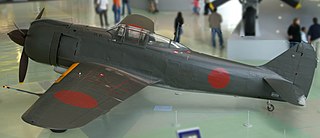
The Kawasaki Ki-100 (キ100) is a single-seat single-engine monoplane fighter aircraft used by the Imperial Japanese Army Air Service during World War II. The Japanese Army designation was "Type 5 Fighter". It was not assigned an Allied code name.

The Nakajima Ki-84 Hayate is a single-seat fighter flown by the Imperial Japanese Army Air Service in the last two years of World War II. The Allied reporting name was "Frank"; the Japanese Army designation was Army Type 4 Fighter. The Ki-84 is generally considered the best Japanese fighter to operate in large numbers during the conflict. The aircraft boasted high speed and excellent maneuverability with an armament that gave it formidable firepower. The Ki-84's performance matched that of any single-engine Allied fighter it faced, and its operational ceiling enabled it to intercept high-flying B-29 Superfortress bombers. Pilots and crews in the field learned to take care with the plane's high-maintenance Nakajima Homare engine and a landing gear prone to buckling. The difficulties of Japan's situation late in the war took a toll on the aircraft's field performance as manufacturing defects multiplied, good quality fuel proved difficult to procure, and experienced pilots grew scarce. Nevertheless, a well-maintained Ki-84 was Japan's fastest fighter. A total of 3,514 aircraft were built.
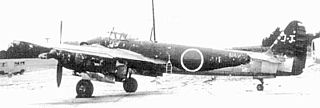
The Nakajima J5N was an abandoned Japanese prototype fighter aircraft of the World War II era. J5N was developed as twin-engine interceptor for countering attacks by Boeing B-29 Superfortress.

The Kawasaki Ki-45 Toryu was a two-seat, twin-engine heavy fighter used by the Imperial Japanese Army in World War II. The army gave it the designation "Type 2 Two-Seat Fighter"; the Allied reporting name was "Nick". Originally serving as a long-range escort-fighter, the design — as with most heavy fighters of the period — fell prey to smaller, lighter, more agile single-engine fighters. As such, the Ki-45 instead served as a day and nighttime interceptor and strike fighter.

The Kawasaki Ki-10 was the last biplane fighter used by the Imperial Japanese Army, entering service in 1935. Built by Kawasaki Kōkūki Kōgyō K.K. for the Imperial Japanese Army, it saw combat service in Manchukuo and in North China during the early stages of the Second Sino-Japanese War. Its reporting name given by the Allies was "Perry".
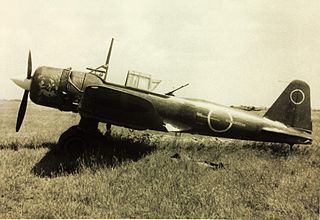
The Mitsubishi Ki-51 was a light bomber/dive bomber in service with the Imperial Japanese Army during World War II. It first flew in mid-1939. Initially deployed against Chinese forces, it proved to be too slow to hold up against the fighter aircraft of the other Allied powers. However, it performed a useful ground-attack role in the China-Burma-India theater, notably from airfields too rough for many other aircraft. As the war drew to a close, the Japanese began using them in kamikaze attacks. Total production was around 2,385 units.
The Kawasaki Ki-102 or Type 4 Attack Plane was a Japanese warplane of World War II. It was a twin-engine, two-seat, long-range heavy fighter developed to replace the Ki-45 Toryu. Three versions were planned: the Ki-102 Kō day fighter, Ki-102 Otsu ground-attack and Ki-102 Hei night fighter. This aircraft's Allied reporting name was "Randy".

The Kawasaki Ki-32 was a Japanese light bomber aircraft of World War II. It was a single-engine, two-seat, mid-wing, cantilever monoplane with a fixed tailwheel undercarriage. An internal bomb bay accommodated a 300 kg (660 lb) offensive load, supplemented by 150 kg (330 lb) of bombs on external racks. During the war, it was known by the Allies by the name Mary.

The Tachikawa Ki-55 was a Japanese advanced trainer.

The Kawasaki Ki-96 was a Japanese single seat, twin-engine heavy fighter of World War II. It was intended to replace the Kawasaki Ki-45s of the Imperial Japanese Army Air Service. However, it was not adopted and only three prototypes were built.
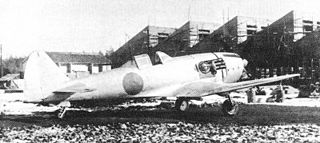
The Nakajima Ki-87 was a Japanese high-altitude fighter-interceptor of World War II. It was a single seat, exhaust-driven turbo-supercharged engined, low-wing monoplane with a conventional undercarriage.

The Nakajima Ki-49Donryu was a twin-engine Japanese World War II heavy bomber. It was designed to carry out daylight bombing missions, without the protection of escort fighters. Consequently, while its official designation, Army Type 100 Heavy Bomber, was accurate in regard to its formidable defensive armament and armor, these features restricted the Ki-49 to payloads comparable to those of lighter medium bombers – the initial production variant could carry only 1,000 kg (2,200 lb) of bombs.

The Mitsubishi Ki-30 was a Japanese light bomber of World War II. It was a single-engine, mid-wing, cantilever monoplane of stressed-skin construction with a fixed tailwheel undercarriage and a long transparent cockpit canopy. The type had significance in being the first Japanese aircraft to be powered by a modern two-row radial engine. During the war, it was known by the Allies by the name Ann.

The Mitsubishi Ki-83 (キ83) was a Japanese experimental long range heavy fighter designed near the end of World War II. It did not reach production status.

The Kawasaki Ki-28, World War II Allied reporting name "Bob", was an experimental fighter aircraft designed for the Imperial Japanese Army and meant as a replacement for the Kawasaki Ki-10. It flew in 1936, but was never produced for actual use as the Army chose the Nakajima Ki-27.

The Aichi S1A Denko was a Japanese night fighter, intended to replace the Nakajima J1N1-S Gekkou. Like the Gekkou, it was to be equipped with radar to counter the B-29 air raids over Japan. Development time for the S1A increased while trying to overcome design shortcomings, such as the insufficient power of the Navy's requested Nakajima Homare engines, resulting in no aircraft being completed before the war ended.

The Caproni Vizzola F.6 was a World War II-era Italian fighter aircraft built by Caproni. It was a single-seat, low-wing cantilever monoplane with retractable landing gear. Only two prototypes were built, one designated F.6M and the other designated F.6Z.
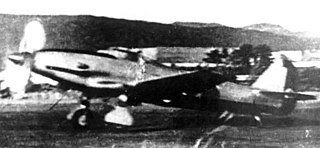
The Kawasaki Ki-64 was a one-off prototype of an experimental heavy, single seat, fighter. It had two unusual design features. First; it had two Kawasaki Ha-40 engines in tandem; one in the aircraft nose, the other behind the cockpit, both being connected by a drive shaft. This combination drove two, three-bladed, contra-rotating propellers. The second feature was the use of the wing surface as a radiator for the water-cooled engines. The aircraft first flew in December 1943. During the fifth flight, the rear engine caught fire; and while the aircraft made an emergency landing, it was damaged. The aircraft was subsequently abandoned in mid-1944 in favour of more promising projects. The airframe survived the war, and parts of the unique cooling system were sent to Wright Field for examination.
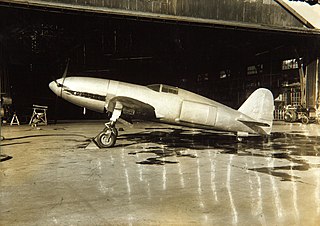
The Kawasaki Ki-78, originally given the designation Ken III, was a high-speed research aircraft, also intended to attempt breaking the world absolute speed record.



















